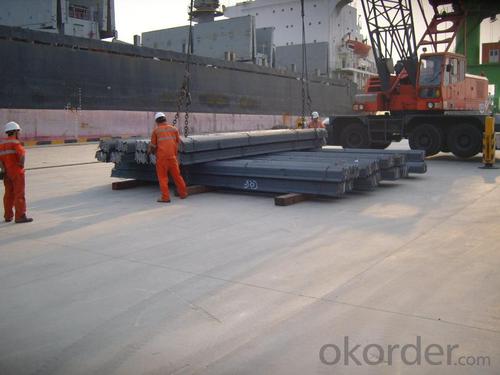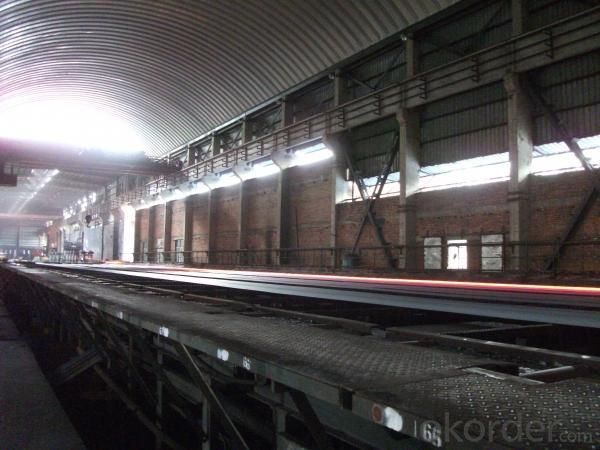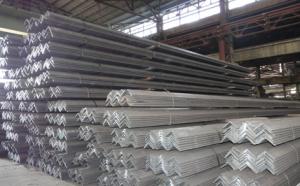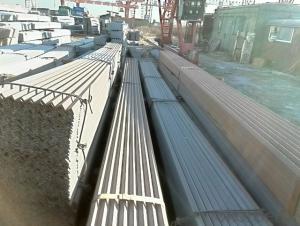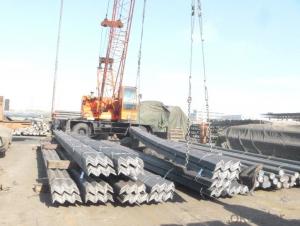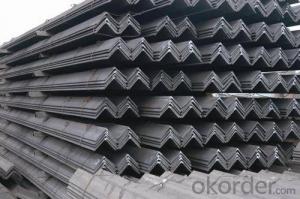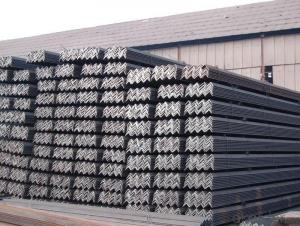Hot Rolled Angle steel
- Loading Port:
- China Main Port
- Payment Terms:
- TT or LC
- Min Order Qty:
- 25m.t. m.t.
- Supply Capability:
- 80000-100000MTS/YEAR m.t./month
OKorder Service Pledge
OKorder Financial Service
You Might Also Like
Specifications of Hot Rolled Angle Steel
1.Standards:GB,ASTM,BS,AISI,DIN,JIS
2. Invoicing on theoretical weight or actual weight as customer request3.Material:GBQ235B,Q345BorEquivalent;ASTMA36;EN10025,S235JR,S355JR;JISG3192,SS400;SS540.
4. Payment terms:
1).100% irrevocable L/C at sight.
2).30% T/T prepaid and the balance against the copy of B/L.
3).30% T/T prepaid and the balance against L/C
5.Sizes:
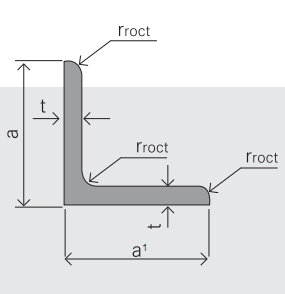
|
EQUAL ANGLES SIZES |
| ||
|
a(mm) |
a1(mm) |
thickness(mm) |
length |
|
25 |
25 |
2.5---3.0 |
6M/12M |
|
30 |
30 |
2.5---4.0 |
6M/12M |
|
38 |
38 |
2.5 |
6M/12M |
|
38 |
38 |
3.0---5.0 |
6M/12M |
|
40 |
40 |
3.0---6.0 |
6M/12M |
|
50 |
50 |
3 |
6M/12M |
|
50 |
50 |
3.7---6.0 |
6M/9M/12M |
|
60 |
60 |
5.0---6.0 |
6M/9M/12M |
|
63 |
63 |
6.0---8.0 |
6M/9M/12M |
|
65 |
65 |
5.0---8.0 |
6M/9M/12M |
|
70 |
70 |
6.0---7.0 |
6M/9M/12M |
|
75 |
75 |
5.0---10.0 |
6M/9M/12M |
|
80 |
80 |
6.0---10.0 |
6M/9M/12M |
|
90 |
90 |
6.0---10.0 |
6M/9M/12M |
|
100 |
100 |
6.0---12.0 |
6M/9M/12M |
|
120 |
120 |
8.0-12.0 |
6M/9M/12M |
|
125 |
125 |
8.0---12.0 |
6M/9M/12M |
|
130 |
130 |
9.0-12.0 |
6M/9M/12M |
|
140 |
140 |
10.0-16.0 |
6M/9M/12M |
|
150 |
150 |
10---15 |
6M/9M/12M |
|
160 |
160 |
10---16 |
6M/9M/12M |
|
180 |
180 |
12---18 |
6M/9M/12M |
|
200 |
200 |
14---20 |
6M/9M/12M |
6. Material details:
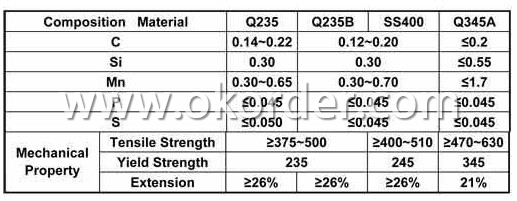
Usage & Applications Hot Rolled Angle Steel
According to the needs of different structures, Angle can compose to different force support component, and also can be the connections between components. It is widely used in various building structures and engineering structures such as roof beams, bridges, transmission towers, hoisting machinery and transport machinery, ships, industrial furnaces, reaction tower, container frame and warehouse etc.
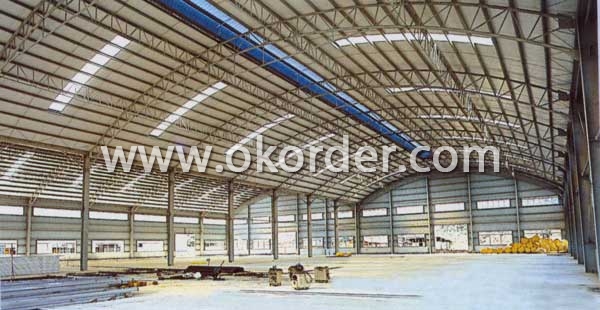
Packaging & Delivery of Hot Rolled Angle Steel
1. Transportation: the goods are delivered by truck from mill to loading port, the maximum quantity can be loaded is around 40MTs by each truck. If the order quantity cannot reach the full truck loaded, the transportation cost per ton will be little higher than full load.
2. With bundles and load in 20 feet/40 feet container, or by bulk cargo, also we could do as customer's request.
3. Marks:
Color mark: There will be color marking on both end of the bundle for the cargo delivered by bulk vessel. That makes it easily to distinguish at the destination port.
Tag mark: There will be tag mark tied up on the bundles. The information usually including supplier logo and name, product name, made in China, shipping marks and other information request by the customer.
If loading by container the marking is not needed, but we will prepare it as customer request.
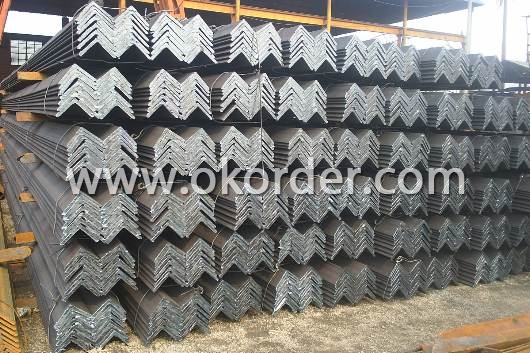
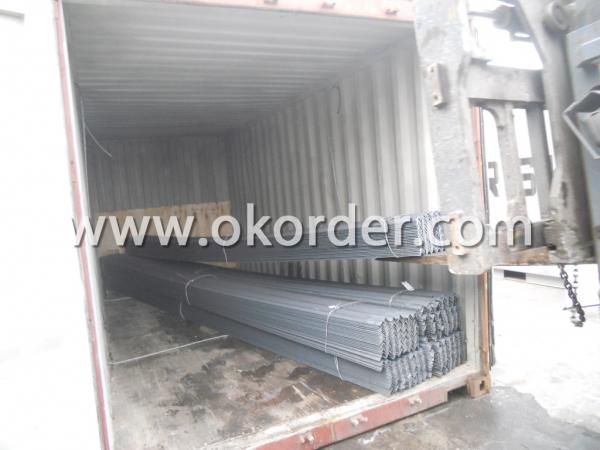
- Q: Can steel angles be used in staircases?
- Yes, steel angles can be used in staircases. Steel angles are commonly used as structural elements in construction due to their strength and versatility. In staircases, steel angles can be used to provide support and stability to the steps and handrails. They are often used as stringers, which are the inclined structural members that support the treads and risers of the staircase. Steel angles can also be used to reinforce the connections between the treads and risers, ensuring the structural integrity of the staircase. Additionally, steel angles can be used as handrails or balusters, providing a secure and durable railing system. Overall, steel angles offer a reliable and cost-effective solution for constructing staircases that can withstand heavy loads and meet the necessary safety standards.
- Q: Can steel angles be used for framing in residential construction?
- Yes, steel angles can be used for framing in residential construction. Steel angles are commonly used as structural elements in construction due to their strength and durability. They can be used to provide support and stability in various framing applications such as wall framing, roof trusses, and floor joists. Steel angles offer several advantages in residential construction, including their resistance to warping, shrinking, and rotting, making them a reliable choice for framing. Additionally, steel angles are fire-resistant, which adds an extra layer of safety in residential buildings. Overall, steel angles are a versatile and cost-effective option for framing in residential construction projects.
- Q: How do steel angles differ from steel channels?
- Steel angles and steel channels are both structural steel shapes that are commonly used in construction and engineering applications. However, they differ in terms of their shape and structural properties. Firstly, steel angles have an L-shaped cross-section, with two legs that are perpendicular to each other. The legs can have equal or unequal lengths, depending on the specific application. This L-shaped design provides greater stability and strength, making steel angles ideal for applications that require load-bearing capabilities, such as supporting beams or columns. They are often used in the construction of frames, braces, and for reinforcing structures. On the other hand, steel channels have a U-shaped cross-section, with a flat bottom and two parallel legs that are connected by a vertical web. The legs of steel channels are usually tapered or have rounded edges. The U-shaped design allows steel channels to provide excellent resistance to bending and torsion, making them suitable for applications that require structural support and stability, such as the construction of framing systems, support beams, and building facades. Another key difference between steel angles and steel channels is their weight-bearing capacity. Steel angles, due to their L-shaped design and shorter legs, are generally more efficient in carrying vertical loads. Conversely, steel channels, with their wider and more extensive cross-section, are better suited to bear horizontal loads. In terms of installation, steel angles are typically bolted or welded to other steel members, providing a strong connection. Steel channels, on the other hand, can be connected by welding, bolting, or even by using clips or brackets, depending on the specific application and load requirements. In summary, steel angles and steel channels differ in terms of their cross-sectional shape, load-bearing capacity, and structural properties. Steel angles are L-shaped and are more suited for vertical load-bearing applications, while steel channels are U-shaped and are better suited for horizontal load-bearing applications. Both shapes have their respective advantages and are commonly used in various construction and engineering projects.
- Q: Can steel angles be used for support beams?
- Yes, steel angles can be used for support beams. Steel angles are commonly used in construction as structural elements due to their strength and durability. They provide excellent support and stability, making them suitable for various applications, including as support beams. Steel angles are often used to reinforce and support structures such as buildings, bridges, and platforms. They can be easily welded or bolted together to create a strong and stable framework. Steel angles come in different sizes and thicknesses, allowing for customization and adaptation to specific load-bearing requirements. Overall, steel angles are a reliable and commonly used option for support beams in construction projects.
- Q: Can steel angles be used in mezzanine or raised platform construction?
- Yes, steel angles can be used in mezzanine or raised platform construction. Steel angles are commonly used as structural supports in construction due to their strength and durability. They can be used as framing elements to create the framework of the mezzanine or raised platform. Steel angles provide stability and support to the structure, ensuring its robustness and ability to withstand heavy loads. Additionally, steel angles can be easily welded or bolted together, making them a versatile choice for construction projects.
- Q: What are the typical uses for steel angles?
- Various industries and construction projects make extensive use of steel angles. Structural framing is one of the most common applications, where steel angles provide added strength and support to buildings and structures. They play a crucial role in creating bracing, reinforcing, and framing elements like beams, columns, and trusses. Steel angles also find significant use in manufacturing and fabrication. They are employed in the production of machinery, equipment, and vehicles due to their ability to withstand heavy loads without bending or warping. They serve as frames, supports, or brackets for various industrial equipment and machinery. Furthermore, steel angles are widely utilized in furniture manufacturing, particularly in metalwork and carpentry. They function as corner brackets or connectors, offering stability and strength to furniture pieces like tables, chairs, and shelves. Additionally, steel angles are commonly integrated into storage racks and shelving systems to ensure durability and stability when holding heavy loads. In the transportation industry, steel angles are frequently incorporated into the manufacturing of trailers, truck beds, and vehicle frames. Their high strength and resistance to impact and vibrations make them well-suited for these applications, ensuring the longevity and structural integrity of the vehicles. Overall, steel angles have a broad range of uses across various industries and projects. Their versatility, strength, and durability make them a sought-after choice for structural support, manufacturing, furniture construction, and numerous other endeavors that demand robustness and stability.
- Q: How much is the weight of 40 * 3 angle steel theory?
- Angle called angle, the steel strip is perpendicular to each other on both sides into the corner. There are equal angles and unequal angles. The two sides of an equal angle steel are equal in width. The specifications are expressed in millimeters of edge width * edge width * edge thickness. Such as "/ 30 x 30 x 3", that is 30 mm width equal angle, edge thickness of 3 mm.
- Q: Can steel angles be used for shelving?
- Yes, steel angles can be used for shelving. Steel angles are commonly used in shelving systems as they provide strength, stability, and durability. They can be easily mounted on walls or used as supports for shelves, making them ideal for various storage applications.
- Q: Can steel angles be used in architectural applications?
- Yes, steel angles can be used in architectural applications. Steel angles are commonly used in construction and architectural projects due to their strength, durability, and versatility. They can be used to provide structural support, reinforce corners and edges, and create aesthetically pleasing designs. Steel angles are often used in the construction of buildings, bridges, and other structures to provide stability and support. They can also be used to create architectural features such as decorative trim, handrails, and window frames. Additionally, steel angles can be easily fabricated and customized to meet specific design requirements, making them a popular choice for architects and designers.
- Q: Can steel angles be used for structural purposes?
- Steel angles are a viable option for structural purposes. In construction and engineering projects, steel angles have a common application of providing support and stability. They are frequently utilized to reinforce and fortify various structural elements like beams, columns, frames, and trusses. The high strength and durability of steel angles make them capable of enduring heavy loads and forces. They possess versatility as they can be effortlessly welded, bolted, or screwed into position, facilitating convenient installation and adaptation to diverse design specifications. Furthermore, steel angles are accessible in multiple dimensions, lengths, and thicknesses, rendering them appropriate for a broad spectrum of structural uses.
1. Manufacturer Overview
| Location | Hebei, China |
| Year Established | 2003 |
| Annual Output Value | Above US$ 500 Million |
| Main Markets | Southeast Asia; middle east; South Korea; Africa |
| Company Certifications | ISO 9001:2008 |
2. Manufacturer Certificates
| a) Certification Name | |
| Range | |
| Reference | |
| Validity Period |
3. Manufacturer Capability
| a) Trade Capacity | |
| Nearest Port | Tianjin |
| Export Percentage | 30%-45% |
| No.of Employees in Trade Department | 11-20 People |
| Language Spoken: | English; Chinese |
| b) Factory Information | |
| Factory Size: | Above 10,000 square meters |
| No. of Production Lines | 2 |
| Contract Manufacturing | OEM service offered |
| Product Price Range | high; average |
Send your message to us
Hot Rolled Angle steel
- Loading Port:
- China Main Port
- Payment Terms:
- TT or LC
- Min Order Qty:
- 25m.t. m.t.
- Supply Capability:
- 80000-100000MTS/YEAR m.t./month
OKorder Service Pledge
OKorder Financial Service
Similar products
Hot products
Hot Searches
Related keywords




